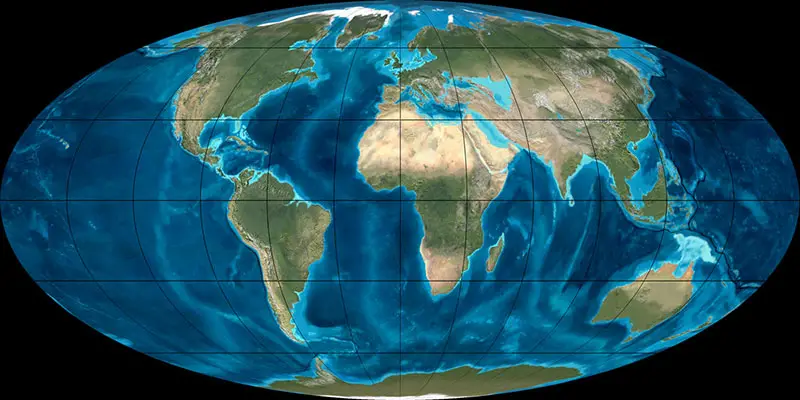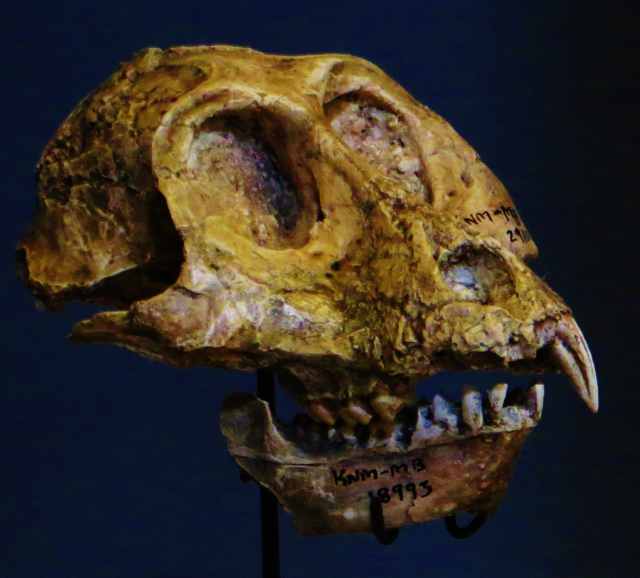†Victoriapithecidae
Victoriapithecidae ist der Familienname von 9 Primaten, die ab dem frühen Neogen (Miozän) im Aquitanium vor 23 Millionen Jahren bis 20,4 Millionen Jahren lebten. Viele Überreste wurden in Kenia gefunden.
Victoriapithecidae ist der Name einer Primatenfamilie innerhalb der Überfamilie Cercopithecoidea (Catarrhini, Altweltaffen oder Schmalnasenprimaten).
Heute gehört nur noch die Gattung Victoriapithecus mit ihrem einzigen Vertreter V. mcinnesi zu dieser Familie, früher zählte man noch die Gattung Prohylobates dazu.
Das Fehlen von Fossilien ist wahrscheinlich ein reales Phänomen. Man glaubt, dass diese Affen zu dieser Zeit tatsächlich nicht recht häufig waren, und dass die unvollständige Fundlage darauf zurückzuführen ist.
| Physiologie | |
|---|---|
| Gewicht: | ? |
| Schwestertaxa | |
Genau wie alle frühen Hominoiden sind auch frühe Altweltaffen aus dem Miozän viel primitiver als ihre heute lebenden, cercopithecoiden Verwandten, daher kann man sie nicht so einfach in eine der modernen Unterfamilien stellen. Vielmehr bilden sie eine eigene Unterfamilie von primitiven Affen, die Victoriapithecinen, die der Auseinanderentwicklung der modernen Colobinae (Schlank- und Stummelaffen) und der Cercopithecidae (Meerkatzen, Makaken und Paviane) voraus gingen.
Literatur
R. Fourtau 1918, . Contribution à l'étude des vertébrés miocènes de l'Égypte. , p. 1 - 109P. Andrews, G. E. Meyer, D. R. Pilbeam, J. A. Van Couvering, J. A. H. Van Couvering 1981, The Miocene fossil beds of Maboko Island, Kenya: Geology, age, taphonomy, and palaeontology. Journal of Human Evolution. 10, p. 35 - 48, DOI: 10.1016/S0047-2484(81)80024-3
M. Pickford, G. E. Meyer, D. R. Pilbeam, J. A. Van Couvering, J. A. H. Van Couvering 1982, New Higher Primate Fossils from the Middle Miocene Deposits at Majiwa and Kaloma, Western Kenya. American Journal of Physical Anthropology. 58, p. 1 - 19, DOI: 10.1016/S0047-2484(81)80024-3
B. R. Benefit, M. L. McCrossin, D. R. Pilbeam, J. A. Van Couvering, J. A. H. Van Couvering 1989, New primate fossils from the Middle Miocene of Maboko Island, Kenya. Journal of Human Evolution. 18, p. 493 - 497, DOI: 10.1016/S0047-2484(81)80024-3
T. Harrison, M. L. McCrossin, D. R. Pilbeam, J. A. Van Couvering, J. A. H. Van Couvering 1989, A new species of Micropithecus from the middle Miocene of Kenya. Journal of Human Evolution. 18:6, p. 537 - 557, DOI: 10.1016/S0047-2484(81)80024-3
C. S. Feibel, F. H. Brown, D. R. Pilbeam, J. A. Van Couvering, J. A. H. Van Couvering 1991, Age of the primate-bearing deposits on Maboko Island, Kenya. Journal of Human Evolution. 21:6, p. 221 - 225, DOI: 10.1016/S0047-2484(81)80024-3
M. Pickford, F. H. Brown, D. R. Pilbeam, J. A. Van Couvering, J. A. H. Van Couvering 1992, Evidence for an arid climate in western Uganda during the middle Miocene. Comptes Rendus Acad. des Sci.,serie II. 315:11, p. 1419 - 1424, DOI: 10.1016/S0047-2484(81)80024-3
M. L. McCrossin, F. H. Brown, D. R. Pilbeam, J. A. Van Couvering, J. A. H. Van Couvering 1992, New species of bushbaby from the Middle Miocene of Maboko Island, Kenya. American Journal of Physical Anthropology. 89:11, p. 215 - 233, DOI: 10.1016/S0047-2484(81)80024-3
A. J. Winkler, F. H. Brown, D. R. Pilbeam, J. A. Van Couvering, J. A. H. Van Couvering 1997, Systematics, Paleobiogeography, and Paleoenvironmental Significance of Rodents from the Ibole Member, Manonga Valley, Tanzania. Neogene Paleontology of the Manonga Valley, Tanzania. Plenum Press, New York and London. :11, p. 311 - 332, DOI: 10.1016/S0047-2484(81)80024-3
M. Pickford, B. Senut, D. Gommery, E. Musiime 2003, New Catarrhine fossils from Moroto II, Early Middle Miocene (ca 17.5 Ma) Uganda. Comptes Rendus Palevol. 2:8, p. 649 - 662, DOI: 10.1016/S0047-2484(81)80024-3
E. R. Miller, B. R. Benefit, M. L. McCrossin, J. M. Plavcan, M. G. Leakey, A. N. El-Barkooky, M. A. Hamdan, M. K. Abdel Gawad, S. M. Hassan, E. L. Simons 2009, Systematics of early and middle Miocene Old World monkeys. Journal of Human Evolution. 57:8, p. 195 - 211, DOI: 10.1016/j.jhevol.2009.06.006

